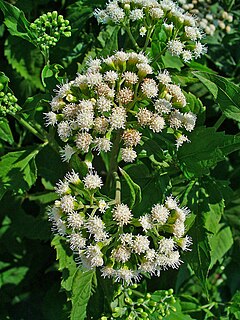
Xylopia aethiopica is an evergreen, aromatic tree, of the Annonaceae family that can grow up to 20m high. It is a native to the lowland rainforest and moist fringe forests in the savanna zones of Africa.

Limnophila aromatica, the rice paddy herb, is a tropical flowering plant in the family Plantaginaceae. It is native to Southeast Asia, where it flourishes in hot temperatures and grows most often in watery environments, particularly in flooded rice fields. It is called ngò ôm or ngò om or ngổ in Vietnam and used as an herb and also cultivated for use as an aquarium plant. The plant was introduced to North America in the 1970s due to Vietnamese immigration following the Vietnam War. It is called "ma om" (ម្អម) in Khmer. It is used in traditional Cambodian soup dishes and Southern Vietnamese cuisine. It can grow in flooded rice paddies during wet season but it grows best on drained but still wet sandy soil of harvested rice paddies for a few months after the rainy season ended. It dies out soon after it flowers. Rural Cambodians often harvest them and put them on the roof of their houses to dry for later use.

Uvaria is a genus of flowering plants in the soursop family, Annonaceae. The generic name uvaria is derived from the Latin uva meaning grape, likely because the edible fruit of some species in the genus resemble grapes.

Xylopia africana is a species of plant in the Annonaceae family. It is found in west-central Africa. It is restricted to submontane and lower montane forests. It is threatened due to habitat loss by clearance of forest. It was first described as Melodorum africanum in 1862 by George Bentham.

Xylopia is a genus of flowering plants in the family Annonaceae. They are mostly trees and some shrubs. There are about 160 species distributed in Asia, Africa, and the Americas.
Xylopia magna is a species of plant in the Annonaceae family. It is a tree found in Malaysia and Singapore.
Xylopia pierrei is a tree species in the family Annonaceae and its native range is Thailand to southern Vietnam.
Xylopia richardii is a species of plant in the Annonaceae family. It is found in Mauritius and Réunion. It is threatened by habitat loss.

Dryobalanops aromatica, commonly known as Borneo camphor, camphor tree, Malay camphor, or Sumatran camphor, is a species of critically endangered plant in the family Dipterocarpaceae. The species name aromatica is derived from Latin and refers to the smell of the dammar (resin). This species was one of the main sources of camphor and attracted early Arab traders to Borneo, at that time being worth more than gold, and used for incense and perfumes.

Xylopia frutescens is a tree species the genus Xylopia and family Annonaceae and its native range is S. Mexico to S. Tropical America.

Jalapão State Park is a state park in the microregion of Jalapão in eastern Tocantins, Brazil. It contains a variety of landscapes including cerrado vegetation, sand dunes and flat-topped plateaus.

α-Viniferin is a stilbene trimer. It can be isolated from Caragana chamlagu and from Caragana sinica and from the stem bark of Dryobalanops aromatica. It is also present in relation to resistance to Botrytis cinerea and Plasmopara viticola in Vitis vinifera and Vitis riparia.

Rhus aromatica, the fragrant sumac, is a deciduous shrub in the family Anacardiaceae native to North America. It is found in southern Canada and nearly all of the lower 48 states except peninsular Florida. It grows in upland open woods, fields, barrens, and rocky cliffs.

Ageratina aromatica, also known as lesser snakeroot and small-leaved white snakeroot, is a North American species of plants in the sunflower family. It is widespread and common across much of the eastern and southern United States from Louisiana to Massachusetts, as far inland as Kentucky and Ohio.

Cerradão is a type of dry forest found in Brazil, associated with the cerrado savanna ecoregion.

The Maracaibo dry forests (NT0222) is an ecoregion in Venezuela around Lake Maracaibo. It contains the country's main oil fields. The habitat is criss-crossed by roads and is severely degraded by farming and livestock grazing.
Xylopia benthamii is a species of flowering plant of the genus Xylopia, described by Robert Elias Fries in 1900. It contains one subspecies: Xylopia benthamii dolichopetala. The species is native to Venezuela, Peru, Brazil and Bolivia.













